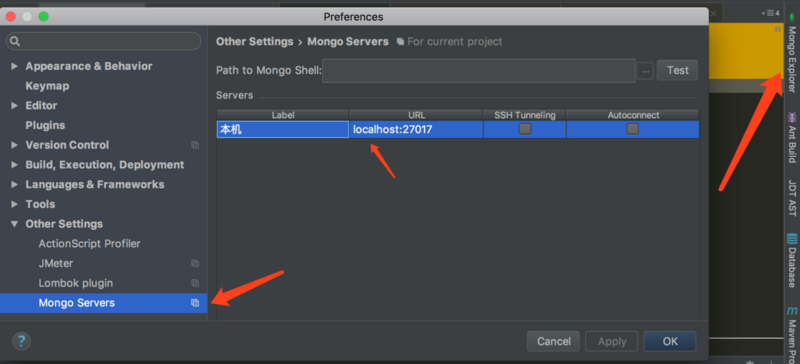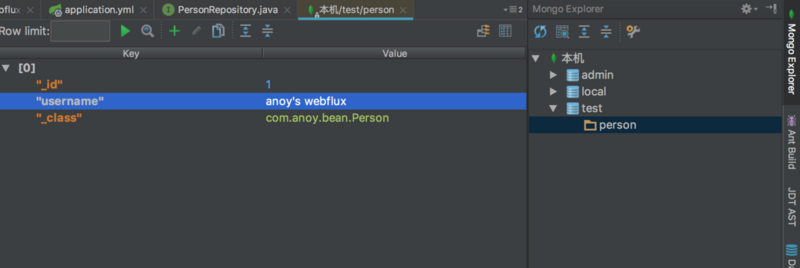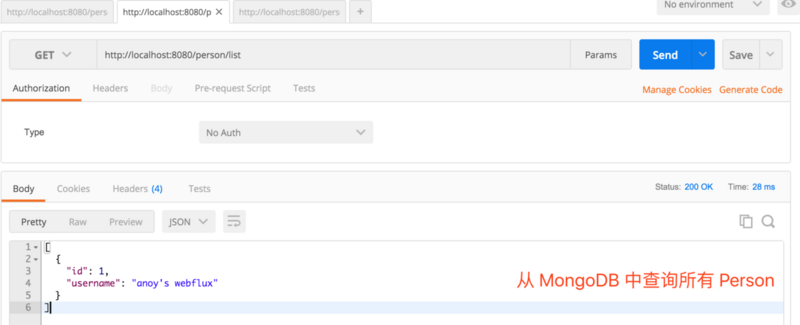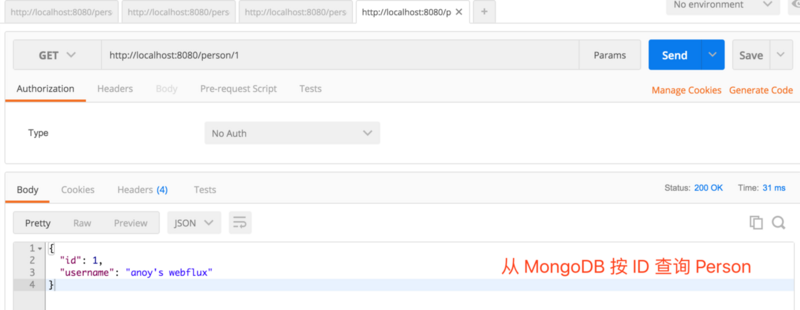基于 Spring Boot 2.0 的实践: WebFlux 集成 MongoDB

1、理论知识
Spring Boot 2.0 - WebFlux framework
2、基于 Spring Boot 2.0 的实践
① 在 docker 上运行 MongoDB
首先,获取 MongoDB 的镜像:
$ docker pull mongo
然后启动 MongoDB 容器
$ docker run -d --name any-mongo -p 27017:27017 mongo
② 构建 Spring Boot 2.0 WebFlux 运行环境
首先,在 IDEA 上新建 Maven 工程,pom.xml 文件内容如下:
<?xml version="1.0" encoding="UTF-8"?>
<project xmlns="http://maven.apache.org/POM/4.0.0"
xmlns:xsi="http://www.w3.org/2001/XMLSchema-instance"
xsi:schemaLocation="http://maven.apache.org/POM/4.0.0 http://maven.apache.org/xsd/maven-4.0.0.xsd">
<modelVersion>4.0.0</modelVersion>
<groupId>com.anoy</groupId>
<artifactId>webflux</artifactId>
<version>1.0-SNAPSHOT</version>
<parent>
<groupId>org.springframework.boot</groupId>
<artifactId>spring-boot-starter-parent</artifactId>
<version>2.0.0.M3</version>
</parent>
<dependencies>
<!-- :heart:不要添加 spring-boot-starter-web -->
<!-- webflux 支持 -->
<dependency>
<groupId>org.springframework.boot</groupId>
<artifactId>spring-boot-starter-webflux</artifactId>
<exclusions>
<!-- 移除 tomcat -->
<exclusion>
<groupId>org.springframework.boot</groupId>
<artifactId>spring-boot-starter-tomcat</artifactId>
</exclusion>
<!-- 移除默认 logging -->
<exclusion>
<groupId>org.springframework.boot</groupId>
<artifactId>spring-boot-starter-logging</artifactId>
</exclusion>
</exclusions>
</dependency>
<!-- :heart:undertow -->
<dependency>
<groupId>org.springframework.boot</groupId>
<artifactId>spring-boot-starter-undertow</artifactId>
</dependency>
<!-- :heart:响应式 MongoDB 支持 -->
<dependency>
<groupId>org.springframework.boot</groupId>
<artifactId>spring-boot-starter-data-mongodb-reactive</artifactId>
</dependency>
<!-- 代码简化 -->
<dependency>
<groupId>org.projectlombok</groupId>
<artifactId>lombok</artifactId>
</dependency>
<!-- 日志 Log4j2 -->
<dependency>
<groupId>org.springframework.boot</groupId>
<artifactId>spring-boot-starter-log4j2</artifactId>
</dependency>
</dependencies>
<repositories>
<repository>
<id>spring-milestones</id>
<name>Spring Milestones</name>
<url>https://repo.spring.io/libs-milestone</url>
<snapshots>
<enabled>false</enabled>
</snapshots>
</repository>
</repositories>
<build>
<plugins>
<plugin>
<groupId>org.springframework.boot</groupId>
<artifactId>spring-boot-maven-plugin</artifactId>
</plugin>
</plugins>
</build>
</project>
然后,配置 Log4j2,参考如下文章:
Spring Boot Log4j2 日志性能之巅接着,配置 MongoDB,在 application.yml 添加如下内容:
spring:
data:
mongodb:
host: localhost
port: 27017
小技巧:IDEA 有 MongoDB 的插件,可以方便的查看 MongoDB 里面的数据,插件名字:Mongo Plugin

添加 Spring Boot 启动类:
package com.anoy;
import org.springframework.boot.SpringApplication;
import org.springframework.boot.autoconfigure.SpringBootApplication;
@SpringBootApplication
public class Application {
public static void main(String[] args) {
SpringApplication.run(Application.class);
}
}
添加 Person 类:
package com.anoy.bean;
import lombok.AllArgsConstructor;
import lombok.Data;
import lombok.NoArgsConstructor;
import org.springframework.data.annotation.Id;
@Data
@AllArgsConstructor
@NoArgsConstructor
public class Person {
@Id
private Long id;
private String username;
}
添加 PersonRepository,负责操作 MongoDB:
package com.anoy.repository;
import com.anoy.bean.Person;
import org.springframework.context.annotation.Primary;
import org.springframework.data.mongodb.repository.ReactiveMongoRepository;
import org.springframework.stereotype.Repository;
@Repository
@Primary
public interface PersonRepository extends ReactiveMongoRepository<Person, Long>{
}
添加 PersonController , 负责路由:
package com.anoy.controller;
import com.anoy.bean.Person;
import com.anoy.repository.PersonRepository;
import lombok.AllArgsConstructor;
import org.reactivestreams.Publisher;
import org.springframework.web.bind.annotation.*;
import reactor.core.publisher.Flux;
import reactor.core.publisher.Mono;
@RestController
@AllArgsConstructor
public class PersonController {
private final PersonRepository personRepository;
/**
* 正常 MVC 模式
*/
@GetMapping("/")
public String hello(){
return "hello!";
}
/**
* 新增一个 Person
*/
@PostMapping("/person")
public Mono<Void> add(@RequestBody Publisher<Person> person){
return personRepository.insert(person).then();
}
/**
* 根据 ID 查询 Person
*/
@GetMapping("/person/{id}")
public Mono<Person> getById(@PathVariable Long id){
return personRepository.findById(id);
}
/**
* 查询所有 Person
*/
@GetMapping("/person/list")
public Flux<Person> list(){
return personRepository.findAll();
}
/**
* 删除指定 Person
*/
@DeleteMapping("/person/{id}")
public Mono<Void> delete(@PathVariable Long id){
return personRepository.deleteById(id).then();
}
}
③ 测试功能





本文由博客一文多发平台 OpenWrite 发布!
正文到此结束
- 本文标签: Docker apache lib https bean log4j2 代码 REST maven 删除 map Spring Boot MongoDB spring build struct Logging stream IDE 插件 db http cat id App schema tomcat 文章 Reactor 数据 list 测试 core find IO CTO final ACE mongo UI XML web src tar plugin 响应式 dependencies pom 博客 springboot 配置
- 版权声明: 本文为互联网转载文章,出处已在文章中说明(部分除外)。如果侵权,请联系本站长删除,谢谢。
- 本文海报: 生成海报一 生成海报二
热门推荐
相关文章
Loading...











![[HBLOG]公众号](https://www.liuhaihua.cn/img/qrcode_gzh.jpg)

